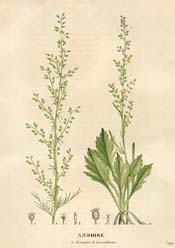
Southernwood, FieldBotanical: Artemisia campestris---Part Used---Herb.
The Field Southernwood is common in most parts of Europe, but rare in Britain, occurring only on sandy heaths in Norfolk and Suffolk. It is perennial, like the other species of Artemisia with a rather thick, tapering root, but uniike them, its foliage is not aromatic. The slender, grooved stems, until flowering, are prostrate; the leaves are silky when young, but nearly smooth when mature, the segments few in number, but very slender, 1/4 to 1/2 inch long, terminating in a point with their margins recurved. The flower-heads are small and numerous, in long, slender, drooping racemes, the florets yellow and are in bloom in August and September.
---Cultivation of Species of Artemisia---The Common Wormwood, Mugwort and Southernwood are regularly cultivated on some of the old established drug farms. They are grown in rows about 2 feet apart each way, and need no further care than to be kept free from weeds, growing in almost any soil. Mugwort and Common Wormwood may also be collected in the wild state. Artemisia Dracunculus is the well-known culinary herb 'Tarragon,' a native of Siberia. It differs from the majority of its fellows in that its leaves are narrow and lance-shaped, of a bright green colour, and possess a peculiar aromatic taste, without the characteristic bitterness of the genus. The Wormwood so frequently mentioned in Scripture is most probably A. judaica, growing in the Southern Desert. See:
© Copyright Protected 1995-2004 botanical.com
|

